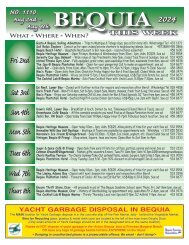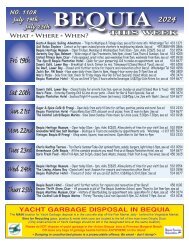Caribbean Compass Yachting Magazine - December 2020
Welcome to Caribbean Compass, the most widely-read boating publication in the Caribbean! THE MOST NEWS YOU CAN USE - feature articles on cruising destinations, regattas, environment, events...
Welcome to Caribbean Compass, the most widely-read boating publication in the Caribbean! THE MOST NEWS YOU CAN USE - feature articles on cruising destinations, regattas, environment, events...
Create successful ePaper yourself
Turn your PDF publications into a flip-book with our unique Google optimized e-Paper software.
CARIBBEAN<br />
ECO-NEWS<br />
Large Marine Animal Sightings<br />
a Welcome Sign in Caymans<br />
Recent sightings of a sperm whale and its calf, and<br />
a large sixgill shark surfacing in local waters are<br />
encouraging signs that demonstrate the Cayman<br />
Islands’ rich diversity, the Department of Environment’s<br />
Tim Austin has said.<br />
Austin, speaking with the Cayman<br />
<strong>Compass</strong> newspaper about the two sightings, said,<br />
“We do have a great diversity of animals and species<br />
here. So it’s nice that people get to see them and that<br />
they are not driven away by constant activity, shipping,<br />
development, or the things that have impacted these<br />
types of species in other areas of the <strong>Caribbean</strong>.”<br />
The two whales were spotted off Seven Mile Beach.<br />
Austin said whales are not an unusual sight in local<br />
waters, but seeing a sperm whale and a calf together<br />
is rare.<br />
The deputy director was also interested in the<br />
sighting of a sixgill shark, since those animals are<br />
usually found in waters 800 feet deep or more. Most<br />
sharks have five gills while this species has six, hence<br />
the name. Austin said, “There’s still very little known<br />
about them because they basically live in such deep<br />
water and out of sight most of the time.”<br />
While Austin said the DoE has not conducted formal<br />
research on the impact of Covid-19 restrictions, which<br />
limited access to local waters and saw the barring of<br />
cruise ships, anecdotal evidence shows the marine<br />
environment is rebounding. For example, he said, the<br />
DoE has started to see turtles nesting in beaches<br />
where they had never been seen before.<br />
“We are seeing less [human] activity on the North<br />
Sound, meaning clearer water, so you see more<br />
starfish. There are lots of things that probably<br />
tangentially are related to the fact that we’re not<br />
having such heavy use of the marine environment and<br />
it just goes to show that the environment can respond<br />
appropriately if it’s managed appropriately,” he said.<br />
Read the full story at www.caymancompass.com<br />
/<strong>2020</strong>/09/03/doe-large-marine-animal-sightings-awelcome-sign.<br />
Slurping Pollution in Simpson Bay Lagoon<br />
The Simpson Bay Lagoon of St. Maarten/St. Martin<br />
is one of the largest inland lagoons in the <strong>Caribbean</strong>.<br />
Its central location provides enormous benefits to the<br />
community through the maritime industry, tourism,<br />
fisheries, and recreation. While some areas still have<br />
the mangrove forests, seagrass beds, and the clear<br />
<strong>Caribbean</strong> waters that one would expect, other more<br />
developed areas exhibit cloudy water, algae mats on<br />
the surface, and a foul odor. The current total economic<br />
value of the lagoon is nearly US$20 million per year<br />
according to a recent study conducted by Environmental<br />
Protection in the <strong>Caribbean</strong> (EPIC) researchers.<br />
However, the study also revealed that this value would<br />
be almost completely lost if the current business-asusual<br />
scenario contributing to water pollution<br />
continues. To prevent pollution entering the lagoon,<br />
EPIC is on the job through the operation of a sewage<br />
pumpout boat, affectionately named Slurpy.<br />
To reduce the amount of sewage entering the lagoon,<br />
this sewage disposal service is offered to the thousands<br />
of boats anchored there annually. Begun in 2013 with<br />
community support, Slurpy’s services are necessary<br />
because there was previously no pumpout service<br />
available. Once the waste is removed from the vessels<br />
and stored in Slurpy’s sealed tank, it is securely<br />
disposed of in a larger land-based holding tank, which<br />
is then pumped out by a septic truck and transported<br />
to the wastewater treatment facility.<br />
Despite an interruption of pumpout services caused<br />
by Hurricane Irma in 2017, EPIC aims to put Slurpy<br />
back to work very shortly.<br />
Visit http://epicislands.org/epic-news/slurpingpollution-in-simpson-bay-lagoon<br />
for more information.<br />
Trinidad & Tobago Joins<br />
International Solar Alliance<br />
As reported in Loop News, Trinidad & Tobago has<br />
joined the International Solar Alliance (ISA) as part of<br />
the country’s goal of creating renewable energy sources<br />
and decreasing carbon output.<br />
The ISA (https://isolaralliance.org) is a coalition of<br />
solar resource-rich countries located between the<br />
Tropic of Cancer and the Tropic of Capricorn aimed at<br />
increasing the utilization of solar energy and<br />
applications in member countries. Cuba, St Lucia,<br />
Dominica, the Dominican Republic, Grenada, Haiti,<br />
Jamaica, St. Kitts & Nevis, St. Vincent & the<br />
Grenadines, and Trinidad & Tobago are all signatories<br />
of the ISA Framework Agreement.<br />
Camille Robinson-Regis, T&T’s Minister of Planning<br />
and Development, said a carbon reduction strategy is<br />
being developed for the three main sectors responsible<br />
for emitting the most carbon: power generation,<br />
transport and industrial.<br />
As part of the Alliance, through cooperation and<br />
mobilization of resources, member countries will be<br />
better able to meet common challenges when scaling<br />
up their solar energy. Key areas of focus for the<br />
Alliance in Trinidad & Tobago include: promoting solar<br />
technologies, new business models and investment in<br />
the solar sector to enhance prosperity; formulating<br />
projects and programmes to promote solar applications;<br />
developing innovative financial mechanisms to reduce<br />
cost of capital; building a common knowledge e-Portal;<br />
and facilitating capacity building for promotion and<br />
absorption of solar technologies and research and<br />
development among member countries.<br />
In line with the sustainable development goal of<br />
ensuring access to affordable, reliable, sustainable<br />
and modern energy for all, the Trinidad & Tobago<br />
government has already begun a solar project in<br />
partnership with the European Union and the United<br />
Nations Development Programme.<br />
The Yacht Services Association of Trinidad and<br />
Tobago (YSATT) welcomes the news of these<br />
developments. While the yachting sector has long<br />
embraced the use of solar energy, extending its use<br />
throughout the country should benefit local communities<br />
and the environment. Solar systems (including solar<br />
panels, batteries, solar controllers, inverters and heavygauge<br />
cable) stocked by chandleries in Chaguaramas<br />
such as Budget Marine can be applied to boats of all<br />
sizes as well as households.<br />
Read the full story at www.looptt.com/content/trinidadand-tobago-now-member-international-solar-alliance.<br />
Sea Turtle Conservation in Bonaire<br />
Every year, Sea Turtle Conservation Bonaire records<br />
approximately 15 green turtle nests on the beaches of<br />
Bonaire and Klein Bonaire. One female lays four or five<br />
nests per season (with approximately 110 eggs per<br />
nest), so this translates to only three or four nesting<br />
green turtles per year. If we lose just one nesting<br />
female, approximately 550 green turtle hatchlings are<br />
“lost” per season, which could add up to several<br />
thousand hatchlings if we account for all the nests she<br />
would have laid during her reproductive life.<br />
Nest monitoring patrols are one of the main<br />
conservation activities conducted by STCB. During<br />
one of these recent patrols on Playa Chikitu, a<br />
stranded green turtle was found. She had laid a nest<br />
near the entrance to the beach and got stuck in<br />
between rocks on her way back to the sea. With the<br />
help of STCB volunteers and partners she was freed<br />
and guided back to the ocean.<br />
You can support sea turtle conservation efforts and<br />
help STCB to monitor nesting beaches by adopting a<br />
sea turtle nest.<br />
Contact stcb@bonaireturtles.org for more information.<br />
<strong>Caribbean</strong> Developers: Build with Nature in Mind!<br />
British High Commissioner to Jamaica, His<br />
Excellency Asif Ahmad, is encouraging developers of<br />
housing and other infrastructure in the <strong>Caribbean</strong> to<br />
“build with nature in mind. It begins with the<br />
fundamentals: understanding the topography of our<br />
land and our marine environment, how the elements<br />
interact with it… we have to build with nature, not<br />
against [it],” he said, addressing the opening ceremony<br />
of the University of the West Indies’ inaugural<br />
<strong>Caribbean</strong> Sustainable Cities Conference last month.<br />
Mr. Ahmad pointed to the need for the updating and<br />
enforcement of building regulations in the <strong>Caribbean</strong><br />
and upgrading the materials used. He is also imploring<br />
developers to ensure that building plans include<br />
rainwater harvesting facilities.<br />
“Rainwater collection has to be built in right from<br />
Day One, not as an afterthought, not as an ugly addon,<br />
but intrinsically, a part of our buildings’ design.<br />
We are not always going to be fortunate with rain at<br />
the right times, as climate change has shown us,” Mr.<br />
Ahmad pointed out.<br />
The Mayor of Montego Bay, Councillor Leeroy<br />
Williams, said that the staging of the conference would<br />
assist the country’s thrust in achieving the United<br />
Nations Sustainable Development Goal 11, which is<br />
aimed at making cities and communities inclusive,<br />
safe and sustainable. The three-day conference, under<br />
the theme “Go Green. Go Safe. Go Smart.” targeted<br />
planners, environmentalists and other stakeholders<br />
interested in realizing sustainable cities, especially in<br />
small island developing states in the <strong>Caribbean</strong>.<br />
Read the full story at https://jis.gov.jm/caribbeandevelopers-urged-to-build-with-nature-in-mind.<br />
‘Atomic Weapon’ Against Marine Sedimentation<br />
Each year, between 750,000 and one million tonnes<br />
of sediments are discharged into the <strong>Caribbean</strong> Sea,<br />
degrading the marine environment and jeopardizing<br />
biodiversity and the regional fishing industries. This is<br />
of particular concern due to the economic value of the<br />
marine environment to the Wider <strong>Caribbean</strong> Region<br />
— approximately 60 percent of the gross national<br />
products of countries in the region depend upon the<br />
health and condition of the sea.<br />
Sediments in seawater are traditionally generated by<br />
natural weathering and soil erosion, but are increasingly<br />
the result of human activities. When they accumulate in<br />
large enough quantities, sediments can threaten the<br />
sustainability and survival of marine life by increasing<br />
turbidity in nearby waters. Suspended sediments reduce<br />
the amount of sunlight reaching the ocean floor, in turn<br />
reducing photosynthesis and leading to die-offs among<br />
marine flora. Additionally, increased turbidity dislodges<br />
fish and amphibian eggs, reduces the competitiveness of<br />
local species, and reduces the aesthetic quality of water,<br />
affecting tourism and recreation.<br />
Through its technical cooperation programme, the<br />
International Atomic Energy Agency, an international<br />
organization that promotes the peaceful use of nuclear<br />
energy, supports marine laboratories in the <strong>Caribbean</strong>,<br />
helping to monitor and analyze the scope and scale of<br />
sedimentation in the region. The analyses and the data<br />
they produce are crucial to the development and<br />
implementation of preservation efforts. Recent training<br />
provided by the IAEA focused on the sampling,<br />
monitoring and study of growing sedimentation in the<br />
<strong>Caribbean</strong> and its effects on marine life, using the<br />
radioisotope of lead.<br />
—Continued on next page<br />
ZSUZSANNA PUSZTAI

















